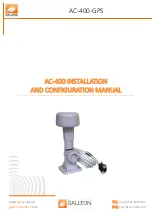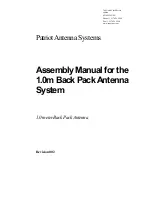
A.H. Systems AK-40G Antenna Kit
©
A.H. Systems inc.
– REV C
8
ASSEMBLY AND MOUNTING INSTRUCTIONS
E-FIELD ANTENNAS
SAS-510-2 Log Periodic Antenna 290 MHz - 2000 MHz
The log periodic antenna comes assembled and ready to use.
Mounting:
Attach the antenna to the tripod azimuth and elevation head
through the screw hole in the antenna base. Connect a cable between the
antenna connector and the receiver. The log periodic beamwidth is 65
degrees and it should be pointed or aimed in the direction that the received
signal is coming from.
SAS-542 Biconical Antenna 20 MHz - 330 MHz
The biconical antenna consists of the SAS-542 balun assembly, two folding
biconical elements and a balun clamp.
Mounting:
Attach the antenna balun clamp (ABC-B) to the top of the tripod
with the ¼-20 thread. Insert the antenna balun into the clamp and secure.
Screw the two biconical elements into the 'tee' end of the balun assembly.
Open the antenna elements completely and secure in open position by
tightening the knurled knobs in the element caps. Connect a cable between
the antenna connector and the receiver. The biconical beam pattern is similar
to a dipole response.
SAS-550-1B Active Monopole Antenna 10kHz - 60 MHz
The active monopole antenna consists of a ground plane upon which are
mounted a preamplifier with internal rechargeable battery pack for battery
operation, and a telescoping rod antenna.
Mounting:
Mount the antenna on the tripod. Connect an external ground to
the ground plane if called out in test specification. Attach the telescoping rod
to the connector on the amplifier top and extend to desired length (typically
41
” or 1 meter depending on test specification). Connect the output on
amplifier side to the receiver using a cable. Apply power to the antenna by
switching activating the power switch. If the Red LED does not illuminate then
the antenna will require charging. The active monopole antenna is omni-
directional.
SAS-571 Double Ridge Guide Horn Antenna 700MHz - 18 GHz
SAS-574 Double Ridge Guide Horn Antennas 18 GHz
– 40 GHz
The SAS-574 horn antenna comes assembled and ready to use. The SAS-
571 antenna mounting bracket is attached to the antenna backwards to
protect the RF connector and fit in the carrying case. The bracket must be
removed from the antenna, turned over (so that the bracket leg faces away
from the antenna), and re-attached to the antenna. (The bracket is not
needed for mounting if the tripod being used has an Azimuth/Elevation Head.)
Mounting:
Attach the antenna to the tripod azimuth and elevation head
through the hole on the antenna bottom or the hole in the mounting bracket.
The ridge guides determine the antenna polarity: for horizontal polarity they
should be parallel to the ground, for vertical polarity they should be
Summary of Contents for AK-40G
Page 1: ...A H Systems AK 40G Antenna Kit A H Systems inc REV C 1 AK 40G Antenna Kit Operation Manual ...
Page 11: ...A H Systems AK 40G Antenna Kit A H Systems inc REV C 11 TYPICAL DATA ...
Page 12: ...A H Systems AK 40G Antenna Kit A H Systems inc REV C 12 ...
Page 13: ...A H Systems AK 40G Antenna Kit A H Systems inc REV C 13 ...
Page 14: ...A H Systems AK 40G Antenna Kit A H Systems inc REV C 14 ...
Page 15: ...A H Systems AK 40G Antenna Kit A H Systems inc REV C 15 ...
Page 16: ...A H Systems AK 40G Antenna Kit A H Systems inc REV C 16 ...






































